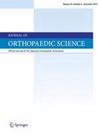对健康成年人负重和不负重时的胫腓骨前间隙进行定量评估:基于超声波的研究
IF 1.5
4区 医学
Q3 ORTHOPEDICS
引用次数: 0
摘要
本文章由计算机程序翻译,如有差异,请以英文原文为准。
A quantitative assessment of the anterior tibiofibular gap with and without weight-bearing in healthy adults: An ultrasound-based study
Background
Difficulties in the accurate evaluation of tibiofibular clear space in plain radiographs are diagnostic problems in the clinical setting of syndesmosis injury. This study aimed to quantify the anterior tibiofibular gap (ATFG) with weight-bearing using ultrasonography.
Methods
In total, 32 healthy adults (16 men and 16 women) with 64 feet participated in this cross-sectional study. The ATFG was measured along the anterior inferior tibiofibular ligament for a US assessment conducted in both sitting and standing postures. The ankle joint was set on the tilt table at four different angles as follows: plantar flexion, 20° (P20); neutral position (N); dorsiflexion, 20° (D20); and dorsiflexion, 20°+ external rotation, 30° (D20ER30). The ankle joint position, sex, and side-to-side values were compared with and without weight-bearing.
Results
Under all ankle angle conditions, the ATFG was wider in the standing posture than in the sitting posture (p < 0.001). In both sitting and standing postures, the ATFG widened with increasing dorsiflexion angle, eventually reaching a maximum at D20ER30. The widening ratio (D20ER30/N) in the standing posture was higher in women than in men (p < 0.05). No statistical differences were identified side-to-side differences in the ATFG.
Conclusions
Ultrasound measurements for identifying unphysiological increases in ATFG with weight bearing, especially given the side-to-side differences, may provide a means for quantitatively assessing syndesmosis injury in a clinical setting. Further research is warranted to clarify direct attribution as a clinical diagnostic utility of the ATFG measurements for syndesmosis injuries.
求助全文
通过发布文献求助,成功后即可免费获取论文全文。
去求助
来源期刊

Journal of Orthopaedic Science
医学-整形外科
CiteScore
3.00
自引率
0.00%
发文量
290
审稿时长
90 days
期刊介绍:
The Journal of Orthopaedic Science is the official peer-reviewed journal of the Japanese Orthopaedic Association. The journal publishes the latest researches and topical debates in all fields of clinical and experimental orthopaedics, including musculoskeletal medicine, sports medicine, locomotive syndrome, trauma, paediatrics, oncology and biomaterials, as well as basic researches.
 求助内容:
求助内容: 应助结果提醒方式:
应助结果提醒方式:


